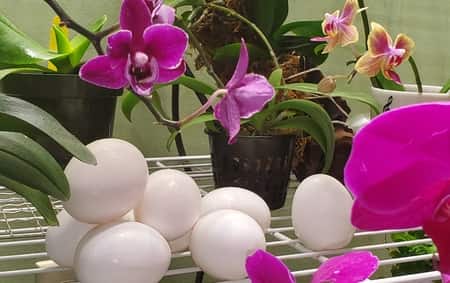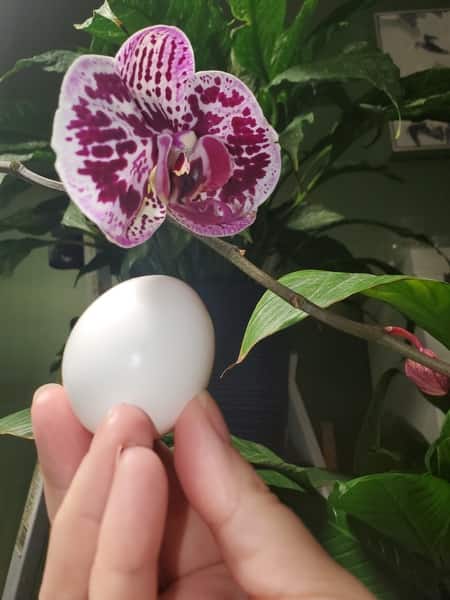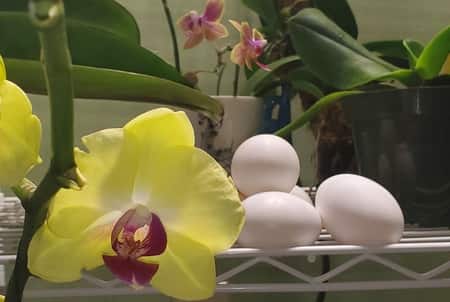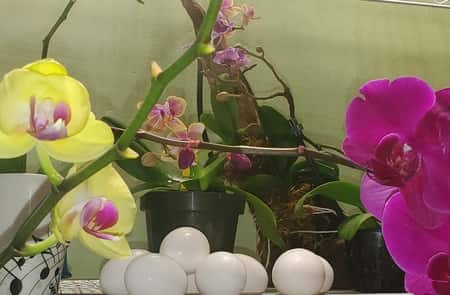If you’ve grown orchids for a while, you’ve probably run across the question of using eggshells as a calcium supplement for orchid fertilizer. When you start researching what all goes into the fertilizers, it’s almost natural that you’d want to take a step back and refrain from commercially produced brands. The chemical overload in these fertilizers is nothing to joke about. The next step in this thinking process, is why not make your own?
Do eggshells provide any benefits to your orchid?
Eggshell fertilizer benefits your orchid by strengthening the orchid’s cell wall, making it stronger and less prone to outside influences, like root rot. Calcium from the eggshells also reduces salt build-up and prevents chlorosis. The cells will become sturdier and firmer, and in the long run, the orchid’s growth will become larger.

Eggshells, banana peels, tea bags, molasses, cucumber skin, potato rinds, coffee grounds… What is actually a good idea for a fertilizer supplement, and what is a pure waste of time?
In this article, I’ll focus only on eggshells, and the pros and cons of using it as a fertilizer in your orchid potting mix.
By the way, there is a video of this article at the end. If you don’t want to read the whole thing, skip down to end. 🙂
Eggshell Calcium Prevents Root Rot in Your Orchid
Calcium will prevent (to some extent) root rot. An orchid that has higher levels of calcium will be less prone to suffer the ill-effects of root rot. I say to some extent because no amount of calcium can reverse the effects of over-watering—either too much or too often—and calcium itself is not a rot prevention treatment. It also can’t help if your potting medium is stuffed into the pot that your roots can’t breathe.
When in a fine powder form, water will take calcium from the top of the pot and bring it into the medium. Inside the potting mix, calcium reacts with the excess salt and reduces the sodium quantity. This is excellent news for those who tend to over-fertilize.
Again, this isn’t a 100% guaranteed method, but it will reduce the salt content slightly. Once inside the roots, calcium does not circulate freely through the orchid. The velamen absorbs the calcium and it is transported by means of xylem to the nearest cell wall.
There it will stay.
The newest growth will receive the calcium last, as the calcium deposits to not travel where needed, but where is closest.

What are the signs of Calcium Deficiency in Orchids?
Because of the way calcium is absorbed in the plant, the lack of calcium will show up in the newest leaves first. You can tell your orchid needs the calcium provided from the eggshells because the tips of the leaves will start to deform.
Pseudobulbs, leaves, and canes will not be as plush and plump, and growth is stunted from calcium-deficiency. The lack of calcium to orchids will produce short, smaller plants, stunting their full growth. If you take a look at the roots, you’ll see brown and black roots, a clear sign of future (if not present) root rot.
Once established inside the cell wall, the calcium will enhance it, making it more resistant and stronger. This produces stronger leaves and in the long term, a larger, fuller, more vibrant orchid.
What Nutrients can Eggshells provide for my Orchid?
Eggshells are composed of almost 94% Calcium Carbonate (CaCO3), so it’s mainly pure calcium. When crushed into a fine powder and sprinkled over the top of the potting medium, eggshells also provide numerous trace elements in lesser quantities: copper, iron, magnesium, phosphorus, potassium, and zinc. All these can aid your orchid’s growth.
A store-bought fertilizer will contain basically three ingredients: Nitrogen (N), Phosphorous (P), and Potassium (K). When you purchase fertilizers, they will have these three in a ratio, known as the N-P-K ratio, representing each element individually. Calcium is not one of them.
In nature, orchids don’t just live on these three elements alone. By attaching themselves to tree bark and living under the thick canopy of forest leaves overhead, orchids get a very rich supply of nutrients, although they be quite few in quantity.
That is why it is advised to fertilize weakly, weekly. Orchids don’t need that much fertilizer to survive, and too much will cause root burn and browning of the tips of the leaves. Yet they do get a huge variety of nutrients…like a buffet service, just not all you can eat buffet.

Commercially sold fertilizers only specialize in N-P-K because that is what most houseplants need and is the basic, bare-minimum of what any plant needs.
If you can supplement calcium, magnesium, and other elements into your orchid mix (remember, in extremely low quantities) it is beneficial to your orchid.
Too Many Eggshells on Orchids: An Overdose of Calcium
Eggshells have proven to be beneficial to your orchid when used in sparing quantities. Don’t use too much, because the calcium will become harmful.
Like everything in life, too much is toxic.
I’m not a chemist, so forgive this explanation…but the calcium hinders other nutrients to be absorbed. The excess calcium competes with the other nutrients and wins every time. It’s not that the orchid won’t absorb as much phosphorus, potassium, magnesium, boron, copper, iron, or zinc—it won’t absorb any.
When there is an excess, calcium will take the upper hand, even if they are present in the potting medium. In other words, don’t use the crushed eggshells every other month… Apply the crushed eggshells once or twice a year, and no more.
The powder will remain in the potting medium for a long time unless you soak your orchid in a bath treatment.
If you decide to use the water that was boiled with eggshells, (I’ll explain this technique later on below) you can use this once every month, or every other month.
Why Produce Your Own Orchid fertilizer?
You may be wondering why go to all that work of producing your own orchid fertilizer supplements, especially ground eggshells. There are some pros in making your own fertilizer at home, not to substitute the N-P-K store-bought ones, but to supplement the elements they don’t provide. I could never suggest giving up on N-P-K fertilizers, but I do believe in supplementing them with other ingredients.
First, it can eliminate waste. What else will you do with your eggshells? Throw them away?
Second,they are cheaper to make from products you have at home, then it is to buy it. Used eggshells are free… After all, they otherwise would be are going to the trash, right?
Third, you know exactly what goes into the fertilizer. You aren’t adding any chemically processed ingredients that could be harmful to the environment or to the plant. Who knows what toxins chemically produced fertilizers have added?
Maybe crushing, baking, pulverizing, and using eggshells is not your thing… On the market, the closest product you can buy to enhance Calcium is Calcite (Limestone) or Dolomite. Both these are rich in calcium. You can also purchase Cal-mag.
I personally can’t recommend one over another, since I haven’t tested them all.
Eggshells as Fertilizers for Terrestrial Orchids
Some growers love to use the broken-up eggshells into pieces that are visible yet small and scatter them around the outdoors garden.
This is a great way to prevent slugs from crawling all over your terrestrial orchids, since the sharp edges of the eggshells will dilacerate their bodies.

If you add the bigger pieces to the orchid pot, it will do nothing. Absolutely nothing. The water that comes into contact with the eggshell will not have had the time that to extract the calcium and potassium as it would if the pieces were ground into a fine powder.
There are some downsides to using the eggshells outside either for terrestrial orchids or other plants. They may be a hindrance to slugs, but they attract birds. Household pets are also prone to digging up the eggshells, be it for fun or some other reason.
(Yeah, thanks a lot, Max…🐕)
If you decide to go this route, my suggestion is to bake the broken eggshells in the oven for 20 minutes. Even though the eggshells don’t smell now, they will eventually. Baking them will prevent the egg smell from taking over the garden.
You can also dig a small trench around your orchids and bury the eggshells. My dog still likes to dig these up, since he can smell a butterfly three miles away, so an eggshell is easy peasy…but at least I don’t smell the eggshells. But I only do this because I don’t bake mine.
Crushed Eggshells Aren’t the only Way to Add Calcium to Your Orchid
If you aren’t fond of cleaning out the fine powder from the blender, another way to extract that extra calcium is to boil 12 to 24 eggshells in water for an hour. Let this water rest overnight in the water, with the eggshells still in the pot.
In the morning, take out the eggshells, and use this water to hydrate your orchids. This is an excellent way to take the chlorine out of the water since it evaporates during the boiling process.
Using Eggshells as Orchid Fertilizers Video
Further Reading Suggestions:
Don’t just take my word for what is written here. Continue researching other articles about eggshells as fertilizers because everyone has a different point of view and unique techniques that work for them. Here are a few other articles from other websites if you’d like to continue your research on eggshells applied to orchid for fertilization purposes:
-” Application of eggshell as fertilizer and calcium supplement tablet ” written by M Gaonkar, published in the International Journal of Innovative Research in Science, Engineering and Technology states that, “We can conclude that artificial chicken eggshell has rich amount of calcium and this calcium can be used very effectively in various applications. When used as a fertilizer it enriched the pH and calcium content of the soil.This enrichment is very beneficial for plants suffering from blossom –end –root diseases. Examples are :Tomato plants,Berry plants etc.” Although the article is not orchid-specific, it does highlight the benefits of eggshells as a great calcium supplement. When you click on the title, you’ll be redirected to the full PDF document.
” written by M Gaonkar, published in the International Journal of Innovative Research in Science, Engineering and Technology states that, “We can conclude that artificial chicken eggshell has rich amount of calcium and this calcium can be used very effectively in various applications. When used as a fertilizer it enriched the pH and calcium content of the soil.This enrichment is very beneficial for plants suffering from blossom –end –root diseases. Examples are :Tomato plants,Berry plants etc.” Although the article is not orchid-specific, it does highlight the benefits of eggshells as a great calcium supplement. When you click on the title, you’ll be redirected to the full PDF document.
– “A Review of the Uses of Poultry Eggshells and Shell Membranes ” written by A.M. King’ori, published in the International Journal of Poultry Science talks about how “discarded eggshells are often used as a plant fertilizer and are effective liming sources.This is because eggshells contain calcium that raises, or neutralizes, the pH level of overly acidic soil.”
” written by A.M. King’ori, published in the International Journal of Poultry Science talks about how “discarded eggshells are often used as a plant fertilizer and are effective liming sources.This is because eggshells contain calcium that raises, or neutralizes, the pH level of overly acidic soil.”
-“EVALUATION OF EGGSHELL AS ORGANIC FERTILIZER ON SWEET BASIL “ written by V. T. Wijaya, published in the International Journal of Sustainable Agricultural Research talks aboutthe effects of eggshells on basil. Even though not related to orchids, I included this article because it compares store-bought fertilizers to the crushed eggshell method produced at home. So next time you want to add a little extra help to your potting mix, add crushed eggshells. Start saving them in a jar after you wash them off and let them air dry. Funny, but they don’t smell when stored like this. When you have enough, grind them, boil them, or whatever your preferred technique is, and add them to your pot.
“ written by V. T. Wijaya, published in the International Journal of Sustainable Agricultural Research talks aboutthe effects of eggshells on basil. Even though not related to orchids, I included this article because it compares store-bought fertilizers to the crushed eggshell method produced at home. So next time you want to add a little extra help to your potting mix, add crushed eggshells. Start saving them in a jar after you wash them off and let them air dry. Funny, but they don’t smell when stored like this. When you have enough, grind them, boil them, or whatever your preferred technique is, and add them to your pot.
If you liked this article and have a few more questions about orchid fertilization, click on the fertilization guide below, and get a free 14-page downloadable guide you can print off from your computer.
Don’t Stop Learning!
If you want to be included in more information and get a 14-page fertilization guide, please sign up for my newsletter. I don’t spam, but send emails out bi-monthly with some curious topics of interest. If you want more information, click here to go to a specific page on this website where I explain it more in detail.

Also, if you are looking for an orchid journal to keep your notes specifically about orchid care, check out my 2 solutions for that on this page. If note-keeping isn’t your thing, then there is a free excel spreadsheet that you can download. Click here for more information on how to do that.
If you subscribe to my newsletter, I will send you a 14-page guide on the main tips of orchid fertilizer. It is downloadable and you can print it out on your computer. I designed the guide to double up as a coloring book, just to make it fun.
Happy Cultivating!


This is very help full my orchid has rested for four month and it looks as though she is getting ready to bloom again. She is quickly becoming A favorite of mine along with the Thanksgiving, Christmas, and Easter cactus.
Hi Virginia,
Thank you so much for commenting. I appreciate it.
-Amanda
Very informative and easily understood. I have used eggshells for a few years now, but I think possibly I applied a little too often. Today, I took my orchid out of the pot and see small shell like substance on the bottom. Live and learn.
What I really want to write about are pests. I usually do not have any, but most recently found very small, very white, somewhat hard (much like sugar) spread next to stem where the leaf projects. I removed them with much effort. Fortunately not too many. I have researched and find nothing that relates. There doesn’t seem to be damage to the plant, but I have noticed that the tips of the leaves (older ones) have started to turn brown. Also the aerial roots seem a little shriveled. Underground roots were healthy and very plentiful. I’m assuming I didn’t water enough and will change my routine to see. I’d appreciate hearing about anything that you can think of that was on the orchid. I would hate to think of an insect being there and not knowing it.
I was wondering how many eggshells do you add to your distilled water to start the process?
Hi Catherine,
I don’t have a specific number. As soon as I have a few eggshells saved up, that’s what I use. Usually more than 4, but I never really kept track.
-Amanda
Thanks for the information regarding calcium. I appreciate your video very much. It’s educational. I have plenty of eggshells from my bakery and watching your video gave me an idea on how to use them.
Learning more all the time. Loved this article on eggshells. Orchids are still in their first year for me.
I have kept them happy, but think I need to repot a couple. Can I pot 2 or 3 together?
I love watching your information on orchid fertilizer, incredible to eye.
Enjoying my orchid.
Hi Eileen,
That’s awesome! 🙂
-Amanda